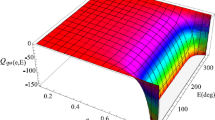Abstract
(7)Formation of celestial bodies. The basic concepts of the accretional process are discussed, and the inadequacy of the contractional model is pointed out. A comparison is made between the general pre-planetary state on the one hand and the present state in the asteroidal region on the other. A model for accretion of resonance-captured grains leading to the formation of resonance-captured planets and satellites is suggested.
(8)Spin and accretion. The relation between the accretional process and the spin of planets is analyzed.
(9)Accretion of planets and satellites. It is shown that jet streams are a necessary intermediate stage in the formation of celestial bodies. The time sequence of planet formation is analyzed, and it is shown that the newly accreted bodies have a characteristic internal heat structure; the cases of the Earth and the Moon are considered in detail. A region of high initial temperature is found at 0.4 of the present Earth radius, whereas the culminating temperature of the Moon is near its present surface. An accretional heat wave is found to proceed outwards, and may produce the observed differentiation features.
Similar content being viewed by others

References
Alfvén, H.: 1967, ‘Partial Corotations of a Magnetized Plasma’,Icarus 7, 387.
Allen, C. W.: 1963,Astrophysical Quantities, 2nd ed., Athlone Press, London.
Anders, E.: 1964, ‘Origin, Age and Composition of Meteorites”,Space Sci. Rev. 3, 583.
Anders, E.: 1965, ‘Fragmentation History of Asteroids’,Space Sci. Rev. 3, 583.
Angus, J. C., Will, H. A., and Stanko, W. S.: 1968, ‘Growth of Diamond Seed Crystals by Vapor Deposition’,J. Appl. Phys. 39, 2915–2922.
Arrhenius, G., Asunmaa, S., Drever, J. I., Everson, J., Fitzgerald, R. W., Frazer, J. Z., Fujita, H., Hanor, J. S., Lal, D., Liang, S. D., Macdougall, D. Reid, A. M., Sinkankas, J., and Wilkening, L.: 1970, ‘Phase Chemistry, Structure and Radiation Effects in Lunar Samples’,Science 167, 659–661.
Asunmaa, S. K., Liang, S. S., and Arrhenius, G.: 1970, ‘Primordial Accretion; Inferences from the Lunar Surface’, Proc. Apollo 11 Lunar Science Conf., Houston, Texas, January 1970, Volume 3, Pergamon Press, p. 1975.
Dole, S. H.: 1962, ‘The Gravitational Concentration of Particles in Space near the Earth’,Planetary Space Sci. 9, p. 541.
Eversole, W. G.: 1958, ‘Synthesis of Diamond’, U.S. 3.030.187 (Cl. 23-209.4) April 17, 1962, Appl. July 23, 1965, 5 pp.
Gault, D. E., Shoemaker, E. M., and Moore, H. J.: 1963, ‘Spray Ejected from the Lunar Surface by Meteoroid Impacts’, NASA TN D-1767.
Giuli, R. T.: 1968, ‘Gravitational Accretion of Small Masses Attracted from Large Distances as a Mechanism for Planetary Rotation’,Icarus 9, 186.
Giuli, R. T.: 1968, ‘On the Rotation of the Earth Produced by Gravitational Accretion of Particles’,Icarus 8, 301.
Herczeg, T.: 1968, ‘Planetary Cosmogonics’ inVistas in Astronomy (ed. by A. Beer), Pergamon Press, London,10, 175–206.
Kuiper, G. P.: 1951, inAstrophysics (ed. by J. A. Hynek), McGraw-Hill, New York, Ch. 8.
Lal, D. and Rajan, R. S.: 1969, ‘Observations on Space Irradiation of Individual Crystals of Gas-rich Meteorites’,Nature 223, 269–271.
Lal, D., Macdougall, D., Wilkening, L. and Arrhenius, G.: 1970, ‘Mixing of the Lunar Regolith and Cosmic Ray Spectra: Evidence from Particle Track Studies’, Proc. Apollo 11 Lunar Science Conf., Houston, Texas, January 1970, Volume 3, Pergamon Press, p. 2295.
Levin, B. J. and Safronov, V. S.: 1960, ‘Some Statistical Problems Concerning the Accumulation of Planets’,Theor. Probab. Appl. 5, 220.
Marcus, A. H.: 1967, ‘Formation of the Planets by the Accretion of Planetesimals: Some Statistical Problems’,Icarus 7, 283.
Öpik, E. J.: 1962, ‘Jupiter: Chemical Composition, Structure and Origin of a Giant Planet’,Icarus 1, 200.
Pellas, P., Poupeau, G., Lorin, J. C., Reeves, H., and Audouze, J.: 1969, ‘Primitive Low-energy Particle Irradiation of Meteoritic Crystals’,Nature 223, 272–274.
Safronov, V. S.: 1958, ‘The Growth of Terrestrial Planets’,Vopr. Kosmog. 6, 63.
Safronov, V. S.: 1960, ‘Accumulation of Terrestrial Planets’,Vopr. Kosmog.,7, 59.
Safronov, V. S.: 1966, ‘Sizes of the Largest Bodies Falling onto the Planets during their Formation’,Sov. Astron. A.J. 9, 987.
Safronov, V. S. and Zvjagina, E. V.: 1969, ‘Relative Sizes of the Largest Bodies during the Accumulation of Planets’,Icarus 10, 109.
Spitzer L.: 1968, ‘Diffuse Matter in Space’, Interscience, New York.
Whipple, F. L.: 1968, ‘On Maintaining the Meteoritic Complex’, 1967,IAU Symposium on Physics and Dynamics of Meteors (ed. L. Kresák and P. Millman), D. Reidel Publishing Company, Dordrecht, The Netherlands.
Wilkening, L., Lal, D., and Reid, A. M.: 1969, ‘Compositions of Irradiated Pyroxenes and Feldspars in the Kapoeta Howardite’, Meteoritical Society, Houston, Texas, Oct. 1969.
Author information
Authors and Affiliations
Rights and permissions
About this article
Cite this article
Alfvén, H., Arrhenius, G. Origin and evolution of the solar system, II. Astrophys Space Sci 9, 3–33 (1970). https://doi.org/10.1007/BF00649952
Received:
Issue Date:
DOI: https://doi.org/10.1007/BF00649952



